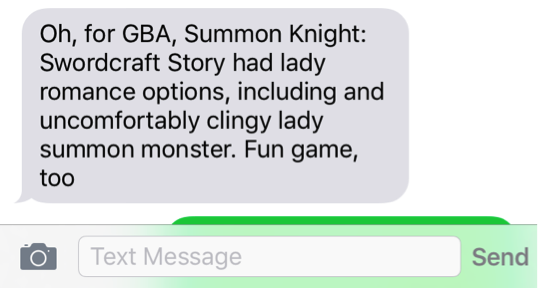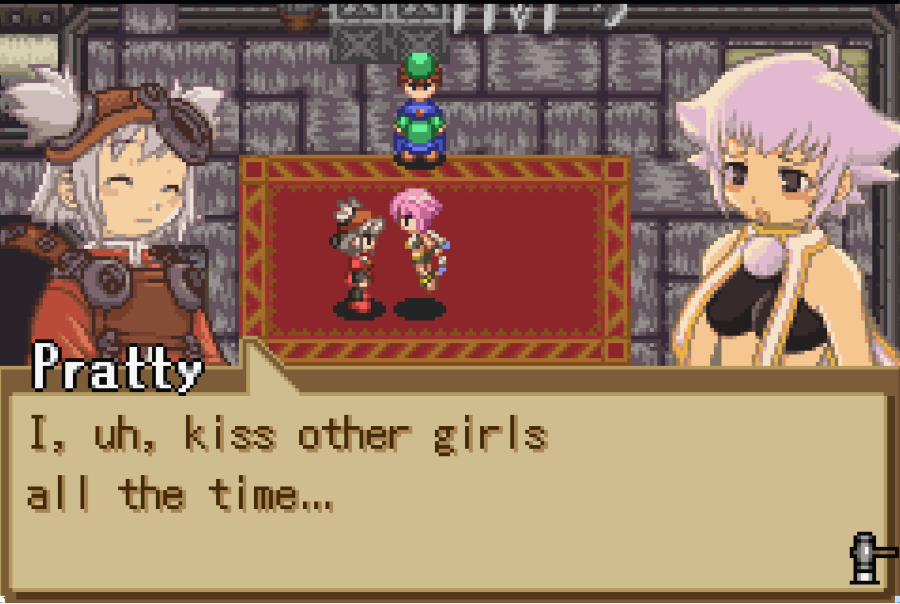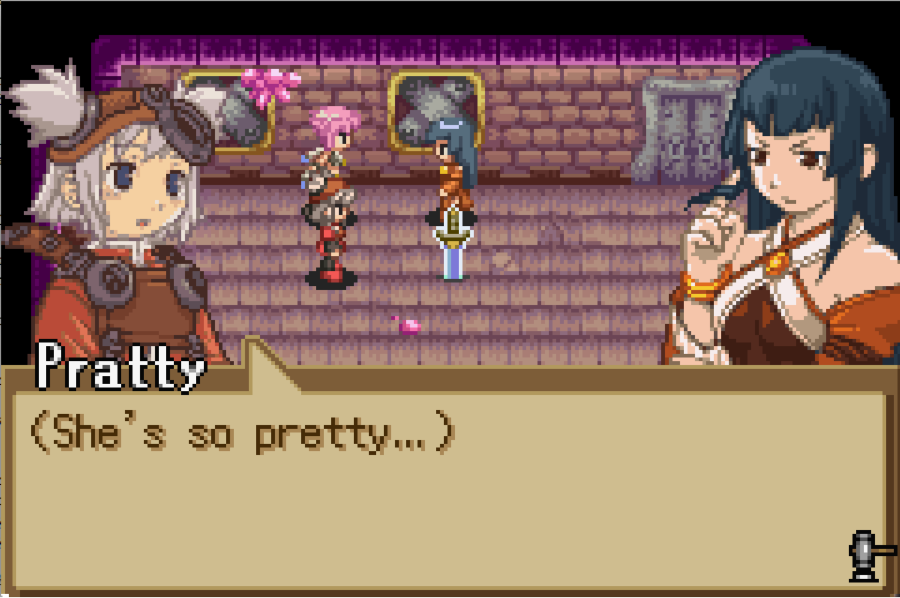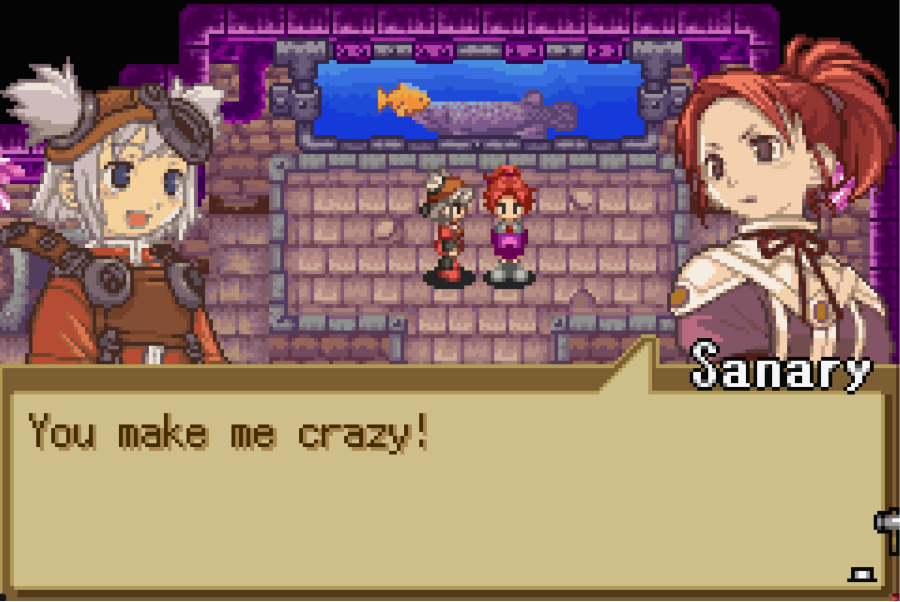Retrogamer: Lesbian Everything
Mia White
This month at Retrogamer, where author and gamer Michael B. Tager experiences classic games for the very first time, we’ll present our first Retro-Guest. Follow along with this new perspective and “new” game.
I’m in the first five minutes of Summon Night: Swordcraft Story. My friend Chloe is over, and she’s watching over my shoulder as I navigate the lengthy dialogue at the beginning of the game.
“Well, that’s a good sign,” I say, as my character calls out her trainer, Bron, for being “sexist.” “Ha, check it out.” I point at the screen to show her my character’s continuing snappy call out.

“Yep.” She doesn’t sound convinced, but I keep clicking through. This should be entertaining, at least.
I’m still clicking through the dialogue, which has now moved into an opening ceremony where a Craftlord explains the lore of the world, tossing in a bit of morality at the end of his long speech. Pratty seems totally bored, and keeps interjecting parenthetical musings on the contents of the speech. She starts thinking about her dead father, a Craftlord who died three years earlier under mysterious circumstances. I start thinking about whether I have fresh ginger to put in the stir fry we are making for dinner. I stifle a yawn.
“When are we going to get to the lesbians?” I lean closer and narrow my eyes, as if they might be hiding just off the screen, or behind some hidden door.
“Just wait. You’ll see.”
For those unfamiliar with the series, Swordcraft Story is a spinoff of Summon Night, a rather extensive bunch of RPGs. I do find out it has—according to a variety of less reliable sources—elements of a visual novel and a dating sim. Had I read this before spending hours on the game, I probably would’ve had a better sense of what was coming.
Swordcraft Story, a 2003 GBA game released in 2006 in the US, is an action RPG. It follows Pratty (or Cleru, should you choose to be a boy) as she works towards being a Craftlord, i.e. the best warrior and weapon maker of all the youngsters competing for the title. It’s nothing groundbreaking, just the standard many-floored dungeon of random encounters and a story that boasts that familiar creeping feeling that your character is going to have to single-handedly save the world.
I have a small obsession with finding lesbians in fictional places. It’s a game I’ve developed, like a cultural “Where’s Waldo,” to cope with the fact that they‘ve been a relatively rare breed in popular culture. These days, things are changing—there are more and more YA books with LGBTQ characters and plots, TV shows are including (and killing off) more lesbians than ever before, and many games are moving towards inclusivity. Here’s a nifty list of more recent titles of lesbian, gay and bisexual options—sadly, there’s very little on the transgender and gender queer front.
My own quest began in my early twenties, when I’d finally moved out of the house and had adequate time to step back into and out of the closet. I’d spent a long time reading books with only straight characters, and was completely used to it. Then, I read Tipping the Velvet, by Sarah Waters. It was like switching on a light inside my… well, you get it.
Even though it was set in Victorian London, I felt a kinship I hadn’t really felt for characters before; mainly, a kinship of attraction. The amazing thing about good literature is that I could see into the mind of characters unlike me, but this didn’t mean there wasn’t something comforting about finally seeing myself on those pages. And of course, given how much sex is in Waters’ books, it was just plain hot.
From there on out, I began obsessively compiling lists of lesbian everything. It wasn’t just about sex; even the mention of a questioning lesbian or bisexual character was enough to get my heart racing. One day, I hope to build a Lesbian Library—with all the lesbian books, movies, and games I can get my dykey hands on.
For now, I’m just amassing a stack of shows, books and movies I need to watch or read. To be honest, I haven’t had a huge amount of time to play games since I was a teenager, but I’ve been meaning to get back into it.
So, I figured I’d kill three birds with one stone: find some new lesbian content, play a new game and write a new piece.
“So which option do I choose again?”
I’ve gotten through the bulk of the pre-story, and I’m finally going to get my Guardian Beast. Basically, every Craftknight needs a companion who fights alongside him or her, and who helps in the crafting of new weapons. Right now, a Summoner is asking Pratty a series of strange questions to determine which beast is best suited to my moral and personal views. I feel a little like I’m taking one of those weird, indirect Buzzfeed quizzes.
My aim is to answer the questions in such a way to get the humanoid, female companion, who my friend has promised makes for some pretty awkward lesbian content.
Chloe glances at the GameFAQ I’ve pulled up. “Hmm,” she says. “So the question is ‘what does love mean to you?’”
“Right.”
“Then you want option 1: ‘caring deeply about someone’.”
“Alright.” I confirm—and the Summoner calls forth a shimmering light.
You’d think this question would’ve been a red-flag of sorts, but it wasn’t. I was way too excited about imminent lesbians to even think about where this was heading.
When I decided to base my lesbian gaming piece on an older game, I was a little at a loss. I ended up asking Chloe—who introduced me to Pokémon back in the late nineties—about her thoughts. She’s easily the most knowledgeable person I know when it comes to video games.
Plus, I knew she’d steer me clear of some of the shittier options: she’s a cynic through and through. She, unlike me, has standards.
She went through a few other titles before she came to Summon Night, which she described in the following text:

Woah, hang on… “uncomfortably clingy lady summon monster”—SOLD.
After the screen flashes white, a pink-haired girl materializes. When I’m given the option of naming her, I see her default name and snort.
“Sugar? Really?”
Chloe laughs uncomfortably. “Yeaaah.”
After thinking for a moment, I shrug and go with the name, even though it’s a little demeaning. It seems best to go for the canon experience. Back when I was a kid, I tended to opt to name everything I could. I named my character whenever I could. I hated the way Pokémon species defaulted to ALL CAPS and waffled over names for almost every monster I caught.
It’s just for the lesbians, I reassure myself.
The first thing Sugar does is ask me to “Please be nice.”
The second thing she does is kiss me.
“Damn,” I say, turning to Chloe and raising my eyebrows. “That was fast.”
“Told ya.”
Meanwhile, Pratty is riding an emotional roller coaster. First, she’s peeved that it has happened, then she is elated with her first kiss, then she is mad when Sugar asks her if she is upset. Finally, she tries play it cool by finishing with this:

Well, shit.
My lesbian vigilance is well-known amongst my friends, to the point where any time my roommate discovers a new work of fiction featuring lesbians, she tells me about it. Another friend joked about my fixation, dubbing it the “Mia reviewing system” and giving the example: “1984. Interesting premise, well-written, no lesbians: two stars.”
Still, I like a good story, with or without lesbians. In the video game world, this openness is a necessity. I’m well aware that in terms of marketing and development, it’s still a straight-dudes world. Even though that is changing, the trend of inclusion really didn’t take off until fairly recently, well after I’d stopped playing many games.
These days, many mainstream series like Fallout or Dragon Age include gay and lesbian options. And don’t get me wrong, this is great, but it often falls into the category of what Chloe calls “inclusivity via lazy writing.” I’m not sure whether I take this stance myself (after all, at least a few of the NPCs respond solely to same-sex advances), but I do understand it. It’s easy enough to put these options into open-world style games, where romance is essentially a side quest.
But what about linear games, where any sense of diversion from the main story is an illusion? What about the games where a character is shot like an arrow towards his or her fate? Where are the LGBTQ options in these?
Chloe has gotten distracted by her own computer, and I plow my way through the rest of the opening scene. I thought the kiss was a bit fast, but within ten minutes Sugar has declared that I’m going to marry her, since my late father promised her his firstborn’s hand.

Pratty protests, citing the fact that she is a girl, but Sugar remains determined. There’s definitely a weird dynamic happening already, and it’s clear from Sugar’s words that she also had feelings for my father. So, strictly speaking, she’s bi or pansexual, or she’s just really into people from Pratty’s family. I’m not sure how to feel.
“This…” I turn to Chloe, who is trying to pull up a Let’s Play of some indie horror game on YouTube. She looks up. “This… is a little weird.”
She nods grimly.
Still, there’s a part of me that is thrilled: that this game even exists, that it was made more than a decade ago, and that there is already so much lesbian action.
As I advance into the game, I end up playing most of it alone. I’m housesitting in a few different spots, so I find myself hunched over my computer all around the city, trying desperately to nudge the game in the Most Lesbian Direction Possible (MLDP).
Admittedly, witty dialogue aside, the game is fun. Like many RPGs, it’s a little grindy and repetitive, which I enjoy in a nostalgic way. Most of the hours I sink into the game are spent delving deeper into the dungeon, trying to get the right materials to make the strongest possible elemental weapons. Even though my gaming skills are rusty—I die way more often than I should—I enjoy the battles and appreciate that it’s not a turn-based system but one that lets me roam around a 2D field at will.
In keeping with my MLDP goals, I have to make a choice: which girl should I go for? Option 1, of course, is Sugar. I’ve got to say though, the fact that she calls me Master makes me deeply uncomfortable, and courting her doesn’t seem like much of a challenge.
There are a lot of other pretty ladies in the game (c’mon, it’s Japanese and it’s got anime style art, what did I expect? After an adolescence of watching a lot of anime, I should know that being a lady tends to be synonymous with being hot or, at the very least, cute). Pratty isn’t exactly a lady killer, but she does notice constantly notice that the women around her are “pretty,” “cute,” or “beautiful.” In fact, this happens with pretty much every single woman I encounter, aside from my mother.

Still, few of them are recurring characters who I can seek out.
That basically leaves me with Sanary, the strong willed redhead with quite a temper. She’s moody, and generally storms off at least once a day. She’s a tomboy, but secretly enjoys dresses. She’s completely determined to win at everything. My kind of lady.

Since she’s in the tournament, this means eventually we will face off against one another. In the real world, if I was in love, I’d let her win, glory be damned. Unfortunately, I know this will mean a Game Over. In the mean time, I do everything I can to make her love me.
My wooing methods are pretty rudimentary: whenever I can flirt with Sanary, I do. Whenever I can choose to meet up with her, I do. If she’s in danger, I will rescue her. If she is mad, I will follow her. In fact, these scenes are few and far between; the main story of the game is focused on the Craftlord tournament. My chances to flirt are rare, and I can’t even tell if it’s making a difference.
At one point during my play through I google “how to get lesbian ending Summon Night.” The first hit is a YouTube video, which I steer away from for fear of spoilers. The second is a review written by a lady gamer who seems thoroughly put off by the lesbianism. She goes so far as to recommend picking the male character to “avoid the blatant lesbian undertones.”
Initially, I think: whatever. This girl is just another drop in the sea of idiot homophobes who can’t appreciate a little inclusion. She just wants all the games she plays to be about her experience. Screw her. Or not, because she is obviously straight and I’m all about consent and wouldn’t want to sleep with her anyway.
But then, another thought occurs to me.
Shit. Is Summon Night just the pre-pubescent equivalent of girl on girl porn? Is this entire game just basically one big teenage straight boy wet dream?
As I felt the reality of this sinking in, I understood once again I’ve been taking things at face value. This should have been obvious from the beginning: this game likely wasn’t written to include lesbians players, but for young boys who grow up to be the type of dude who tries to encourage his lesbian friends to “make out” or who chooses a female avatar to look at her ass.
Whether or not this is the case, I continue playing the game with as much seriousness as I can muster.
The story is picking up. Pratty and her posse of other crafters, following rumors of a strange water vortex, end up on an island far from Wystern. By the time Pratty and Sugar arrive, Sanary and a kid crafter have already been captured by foreign soldiers.
Now I have to choose who to rescue: child or love interest?
Though the rules of society value the life of a child above all else, the choice is clear: according to my MLDP philosophy, I choose Sanary.
(It should be noted my buddy will rescue the child. No death here.)
I finally make it through the monster infested sea cave, and find that her soldier captors have put her in a maid’s outfit. When I approach, she is being forced to make tea for them. I am given a choice–should I storm in now, or keep watching?
It’s just a game, I remind myself, hanging back.
Then, she is asked to give a massage, then to dance. Each time, I’m given the option of barging in, and each time I wait. I lean back from the computer, and take a deep breath. Now that there’s a maid outfit involved, I can’t deny my fan service suspicions. Still, I press on.
Finally, when one of the soldiers insists she kisses him, that’s when Pratty runs in to the rescue. And the thing is, I can’t choose, at this point, to wait. The game has taken over, declared that this is where the line is drawn, that this is when it is time to rescue this girl who is trapped in a room with five horny soldiers. As if before waiting was okay on any level.
Since I started playing this game, I’ve been thinking a lot about inclusivity. About why, exactly, we want to see characters that are like us. I think back again, to Pokémon, and to Harvest Moon, to all the games that eventually shifted into allowing you to be a girl. Even then, I know it is affirmation of some sort of the fact that who we are is acceptable, that we deserve some attention. That our versions of the universal stories of being, of struggling and of love, matter. That we matter.
When I storm in, a giant fish monster busts through the cave wall and chases all the soldiers away. I don’t even get the satisfaction of beating the shit out of those bastards. I do, of course, beat the shit out of the monster.
Afterwards, as Sanary recovers from a scene that was heading undeniably towards sexual assault, Pratty is thinking again about her appearance…

Then, Sanary changes out of the clothes and tells me never to speak of it again.
And I understand now, that I’ve been deluding myself. That yes, they’ve written some funny dialogue that is specific to playing Pratty, who is certainly attracted to women. That is has been fun playing a game that is more than a decade old and feeling, briefly, included. But here’s the thing: just because I’m playing female character doesn’t mean that the male gaze isn’t there. It is there, in the way Pratty thinks about every woman she meets in terms of her appearance. It is there, when she is less concerned about her friend’s emotional state than the dress she is wearing. And even if this isn’t the male gaze, even if there was a lesbian on the development team, it wouldn’t make the recent scene any less fucked up.
And of course, I also understand that this game isn’t rated M. It isn’t even rated T. It’s rated E 10+. So there is no way it could adequately address the reality of this almost-assault. I know though, that it is “humorous” scenes like these that turn out adults who don’t understand consent.
And that’s why, long after I’ve switched off my computer, I keep thinking about this scene:
A girl in a cave with teal walls and ceilings. She’s trapped in a chamber surrounded by men, weaponless, in an outfit that is meant for a servant. They are pushing her to do things. And I am there, unseen. I am hanging back, watching the scene unfold.
